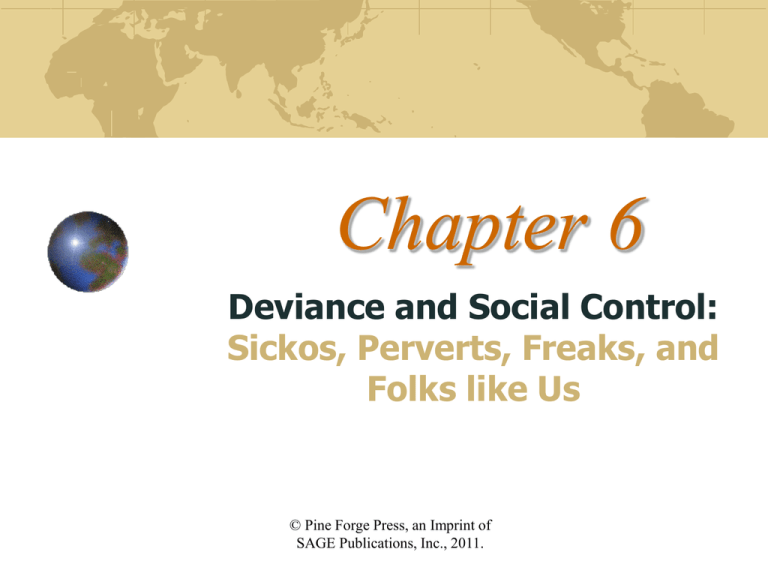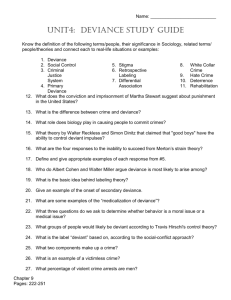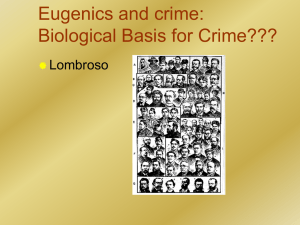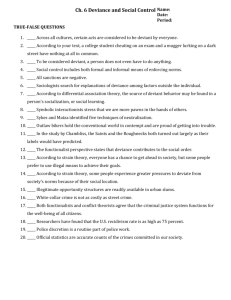Chapter 6: Deviance and Social Control
advertisement

Chapter 6 Deviance and Social Control: Sickos, Perverts, Freaks, and Folks like Us © Pine Forge Press, an Imprint of SAGE Publications, Inc., 2011. What is Deviance? Deviance: the violation of social norms Characteristics of deviance Deviance is socially constructed Acts may be deviant in one time and place but not in others A group or status may be defined as deviant © Pine Forge Press, an Imprint of SAGE Publications, Inc., 2011. Misconceptions About Deviance Belief: Some acts are inherently deviant Fact: Deviance is relative to time, place, & status Belief: Those who deviate are socially recognized Fact: Much deviance goes unrecognized Belief: Deviants break the law purposefully Fact: Deviance is often driven by emotion, disagreements, or situational conditions Belief: Deviance occurs due to human dishonesty and selfishness Fact: People do not attribute their deviance to dishonesty or other negative traits © Pine Forge Press, an Imprint of SAGE Publications, Inc., 2011. Crime: Deviance that Violates the Law Crime: deviance that violates laws and is punished with formal penalties Law: a type of norm that reflects opinions about what is considered right and wrong in a particular society Consensus crimes: members of society agree about the seriousness of the deviant acts Conflict crimes: members of society disagree about the seriousness of the acts, and/or the law disadvantages a particular group © Pine Forge Press, an Imprint of SAGE Publications, Inc., 2011. Theoretical Perspectives Micro-Level Explanations of Deviance: Rational Choice Theories: focus on individual choices, costs, and benefits Interactionist Theories: focus on relationships and meanings © Pine Forge Press, an Imprint of SAGE Publications, Inc., 2011. Theoretical Perspectives Rational Choice Theories of Deviance Individuals make choices about deviance based on costs and benefits to themselves Positive sanctions: rewards (benefits) for socially approved behaviors Negative sanctions: punishments (costs) for breaking social norms Social control occurs when costs of deviance are higher than benefits Punishment should impose high costs for criminal behavior, as a deterrent © Pine Forge Press, an Imprint of SAGE Publications, Inc., 2011. Theoretical Perspectives Rational Choice Theories: Social Control Theory Bonds encourage us to adhere to norms People are bonded to society in 4 ways Attachment to others 2. Commitment to conventional activities 3. Involvement in activities that keep them busy 4. Belief in the social rules of their culture 1. © Pine Forge Press, an Imprint of SAGE Publications, Inc., 2011. Theoretical Perspectives Rational Choice Theories: Social Control Theory, cont. To follow norms, we conform to: Internal controls: voices within that tell us when a behavior is acceptable or unacceptable External controls: society’s formal or informal controls against deviant behavior Social control occurs when we derive more benefit from conformity than deviance © Pine Forge Press, an Imprint of SAGE Publications, Inc., 2011. Theoretical Perspectives Symbolic Interactionist Theories of Deviance Focus on how others shape one’s definition of what is normal and acceptable Examine how society defines some acts as deviant Examine deviance-related symbols and how they affect the self © Pine Forge Press, an Imprint of SAGE Publications, Inc., 2011. Theoretical Perspectives Symbolic Interactionist Theories: Differential Association (or Reinforcement) Theory Focuses on how we learn deviant and criminal behavior from others By associating with others who engage in crime and have criminal values, We learn how to commit crimes Criminal behavior is reinforced Possibility of becoming deviant depends on duration, intensity, priority, and frequency of time spent with deviant others © Pine Forge Press, an Imprint of SAGE Publications, Inc., 2011. Theoretical Perspectives Symbolic Interactionist Theories: Labeling Theory Individuals and behavior become deviant because they are labeled as such Societies define behaviors as deviant and impose sanctions Primary (isolated) deviance—actors are not labeled deviant Secondary (ongoing) deviance—actors are labeled Being labeled reinforces deviant behavior Deviance becomes a self-fulfilling prophecy Those with less power and status are more likely to be labeled as deviant (link to conflict theory) © Pine Forge Press, an Imprint of SAGE Publications, Inc., 2011. Theoretical Perspectives Symbolic Interactionist Theories: General Learning Theory of crime & deviance Combines labeling and differential association theories The effects of labeling depend on the individual’s associations with peer groups © Pine Forge Press, an Imprint of SAGE Publications, Inc., 2011. Theoretical Perspectives Macro and Meso-level Explanations of Deviance Structural Functionalist Theories: focus on anomie and strain Conflict Theories: focus on social inequality and power struggles © Pine Forge Press, an Imprint of SAGE Publications, Inc., 2011. Theoretical Perspectives Structural-Functionalist Theory of Deviance Normally, deviance helps society because it Sets examples of unacceptable behavior Encourages behavior necessary to maintain society Binds people together through common rejection of deviant behavior Provides work for those who deal with deviants Signals social problems that need to be addressed and thereby creates positive change Opens society to creative new ways of thinking © Pine Forge Press, an Imprint of SAGE Publications, Inc., 2011. Theoretical Perspectives Structural-Functionalist Theory, cont. Anomie and social disorganization can cause abnormally high levels of deviance Anomie: a breakdown of norms caused by lack of shared, achievable goals or lack of socially approved means of achieving those goals Anomie is likely in conditions of rapid urbanization, war, or economic change © Pine Forge Press, an Imprint of SAGE Publications, Inc., 2011. Theoretical Perspectives Structural-Functionalist Theory, cont. Strain: another source of deviance Strain: frustration resulting from gap between socially shared goals and access to legitimate methods of achieving those goals Strain causes some people to turn to deviant ways of achieving goals © Pine Forge Press, an Imprint of SAGE Publications, Inc., 2011. Theoretical Perspectives Structural-Functionalist Theory, cont. Strain: five ways of adapting (Merton) Conformity: embracing society's goals and adhering to approved means of achieving them Innovation: using illicit means to reach approved goals Ritualism: strict adherence to social rules, but with no hope of achieving goals Retreatism: giving up on both the goals and the means Rebellion: rejecting socially approved goals and means and replacing them with alternative goals and strategies Deviance: retreatism, rebellion, innovation © Pine Forge Press, an Imprint of SAGE Publications, Inc., 2011. Theoretical Perspectives © Pine Forge Press, an Imprint of SAGE Publications, Inc., 2011. Theoretical Perspectives Conflict Theory of Deviance Deviance results from power struggles between socially unequal groups Elites use deviance to maintain control They have the power to define as deviant activities and groups that threaten their interests or norms To reduce crime and deviance, we must alter the structure of society, making it more equal © Pine Forge Press, an Imprint of SAGE Publications, Inc., 2011. Theoretical Perspectives Feminist Theories of Deviance Women are often victimized or defined as deviant due to secondary social status Low status results from structures such as the gendered division of labor, separation of public and private spheres, and socialized gender roles Women are less often in a position to commit crimes, and women’s crimes differ from men’s Cultural attitudes toward crime against women differ based on the status of women in the society © Pine Forge Press, an Imprint of SAGE Publications, Inc., 2011. Crime and Individuals Crime and individuals: Micro-level analysis How much crime is there? Difficult to estimate because not all crime is reported to police Crime levels and trends are examined using rates per 100,000 individuals There are multiple methods of measuring crime © Pine Forge Press, an Imprint of SAGE Publications, Inc., 2011. Crime and Individuals How crime is measured: Uniform Crime Reports - FBI Type I crimes: murder, rape, robbery, etc. Type II crimes: fraud, simple assault, vandalism, etc. National Incident-Based Reporting System - FBI Self-reported criminal participation surveys Self-reported victimization surveys Each method has flaws; triangulation of data leads to the most accurate results © Pine Forge Press, an Imprint of SAGE Publications, Inc., 2011. Crime and Individuals Predatory or street crime: crimes against individuals or property Victimless or public order crimes: criminal acts committed by or between consenting adults Conflict crimes: not everyone agrees acts ought to be criminalized Hate crimes: criminal offenses motivated by the offender’s bias against a particular social group Hate crimes are committed on the basis of religion, ethnicity or race, national origin, gender, and sexual orientation © Pine Forge Press, an Imprint of SAGE Publications, Inc., 2011. Crime and Organizations Meso-level analysis: Crimes involving organizations & institutions Organized crime: on-going criminal enterprises that aim to obtain personal economic gain through illegitimate means Hierarchically organized; rely on violence, corruption Prominent in societies undergoing transition and/or anomie, and among marginalized groups Activities include sale of illegal goods and services; infiltrating legitimate businesses; extortion Transnational organized crime takes place across borders and is an increasing problem © Pine Forge Press, an Imprint of SAGE Publications, Inc., 2011. Crime and Organizations Crimes involving organizations & institutions Occupational or white-collar crime: violation of the law committed by an individual or group in the course of legitimate, respected occupational or financial activity Types of occupational crimes: Crimes Crimes Crimes Crimes against against against against companies employees consumers the public © Pine Forge Press, an Imprint of SAGE Publications, Inc., 2011. National & Global Crime Macro-Level Analysis: National & Global Crime Terrorism: premeditated, politically motivated violence against noncombatant targets by subnational groups or clandestine agents, usually intended to influence an audience May be domestic or international There are many types of terrorist groups State organized crime: criminal acts committed by government officials E.g., complicity in smuggling, assassination, torture, eavesdropping, accepting bribes, corruption © Pine Forge Press, an Imprint of SAGE Publications, Inc., 2011. National & Global Crime Cross-national comparisons: Crime rates vary across societies due to Different cultural values E.g., different levels of stigma, or disapproval attached to disobeying laws and norms Different levels & causes of economic inequality When income inequality increases, so does crime Variations in overall economic health © Pine Forge Press, an Imprint of SAGE Publications, Inc., 2011. National & Global Crime Global Crimes Global Crime: acts that violate international laws, treaties, and agreements E.g., crimes involving transnational conglomerates that smuggle illegal goods, or nations that violate environmental agreements World systems perspective: sees the cause of global crime as economic inequality and competition between countries Capitalism has increased inequality between core and periphery nations Periphery nations may resort to unconventional means to meet their goals © Pine Forge Press, an Imprint of SAGE Publications, Inc., 2011. National & Global Crime Global internet crime: growing rapidly Internet criminals have a wide audience Sustains an “underground web” of illegal businesses Legitimate internet businesses inadvertently connect people to illegal operations Law enforcement is difficult due to uncertainty about jurisdictions © Pine Forge Press, an Imprint of SAGE Publications, Inc., 2011. Controlling Crime: Policy Considerations The Criminal Justice Process Structural-functionalist perspective: the justice system is important for maintaining order in society Policy should focus on deterring deviance Conflict perspective: the justice system supports the powerful by depicting crime as a threat from poor people and minorities Policy should focus on the injustices of the system © Pine Forge Press, an Imprint of SAGE Publications, Inc., 2011. Controlling Crime: Policy Considerations Prisons and Jails Total institutions: completely control prisoners’ lives and regulate all their activities Inmates’ lives are changed through Degradation: marks inmate as deviant Mortification: breaks down inmate’s original self as he/she experiences resocialization Rigid social systems develop within prisons Jails as “catchall” asylums for the poor, marginalized U.S. incarceration rates have increased due to “get tough” policies © Pine Forge Press, an Imprint of SAGE Publications, Inc., 2011. Comparative Incarceration Rates © Pine Forge Press, an Imprint of SAGE Publications, Inc., 2011. Controlling Crime: Policy Considerations The purposes of prisons From the functional perspective, prisons serve many purposes: Revenge or retribution Removing dangerous people from society Deterrence Rehabilitation However, the recidivism rate is high The likelihood that someone who goes to prison will later be a repeat offender is 75% Suggests deterrence and rehabilitation functions are not working very well © Pine Forge Press, an Imprint of SAGE Publications, Inc., 2011. Controlling Crime: Policy Considerations The Death Penalty (or Capital Punishment) The most controversial method of control Most common argument for the death penalty is that it deters others from committing crime Studies suggest this is not the case; however, the death penalty does serve as retribution The death penalty is most common in Asia, the Middle East, and parts of Africa There is evidence that the death penalty is race and class biased © Pine Forge Press, an Imprint of SAGE Publications, Inc., 2011. Controlling Crime: Policy Considerations Alternative Forms of Social Control For potential offenders: Build social capital (networks, resources, shared values) so as to reduce likelihood of crime and imprisonment For minor offenders: Education or job skills programs Shock probation: early release of first time offenders in hopes that the shock of prison life will deter them Day treatment or half-way houses Community service & work release programs Restitution: offender compensates victim or community Privatization of prison: attempt to make prisons more cost effective, and make a profit © Pine Forge Press, an Imprint of SAGE Publications, Inc., 2011.






